

One and Done
Sources
Search
Contact
Home
The term "One and done" is a good one and accurately describes a significant number of important VAMs for any series. Experienced VAMers know instinctively what these shortcuts are, but they are not always committed to paper. Below are the ones we know and as we learn others they will be posted. These are often the keys that opens the door to finding VAMs of value before others can spot them. Please note, this is circumventing all the detailed discussion about dies and focusing solely on visual keys.
In some regards the VAM 1A is a catch all, but it is also definable. If you have a coin with a spike in the upper loop of the first 8 and you can find no other distinguishing characteristics then you probably have a VAM 1A.
This was the first recognized VAM for the 1881-O series and has been around since
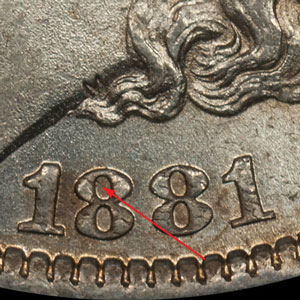
The Aging 1D
Submissions
Clashed Denticle
Date Issues
Encyclopedia
New Orleans and the Mint in 1881
The Devolving 5
One and Done
Two and Through
Fakes
Die Fingerprints
Pricing
The Devolving 27
VAM 1B2 - Die Gouge in DOLLAR, Clashed Obverse n & st
You can actually recognize this VAM by only the two short diagonal clash lines at the neck. There are additional markers just below and at the hair vee, but this is the only VAM with double lines in this configuration.
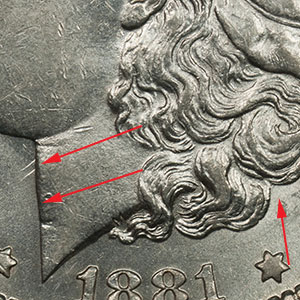
VAM 1D - Pummeled or "Flaky" Eye
One of the most popular and famous VAMs in the 1881-O series is instantly recognizable when you have the coin in hand. If you are buying from photographs or the Internet you need to be more careful because shadows in this area often look like the eye damage.
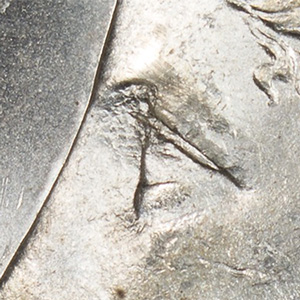
VAM 1F - Pitted Obverse Right Field and Eagle
This is a favorite because the single identifier has nothing to do with the VAM title. This little marker is important because the obverse and reverse pitting develop as the die wears and are not as pronounced. So look for the small die gouge to the right of the eagle's neck. If it is there you have a VAM 1F.
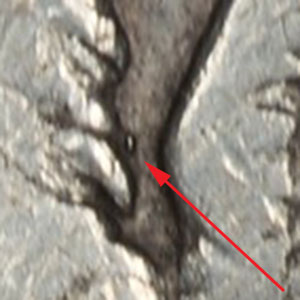
VAM 1G - Die Gouges Inner Wing #1
On VAM 1G the coin is clashed above the right wing and then in the inner wing there is a series of vertical gouges running from southeast to northwest. These are very prominent and hard to miss.

VAM 1H - Die Gouges Inner Wing #2
While the VAM can be identified by the die gouges in the inner wing it is a secondary marker that is easiest to recognize. VAM 1H has a long die crack that runs from the bottom of the nose down toward the bottom of the hair. Often this is accompanied by a second crack that runs horizontally from the neck through the back of the hair. And finally there can be a short crack at the neck termination, and (not shown here) another one running vertically through the tip of the nose. But these last two are not always present.
The challenge with this method of identification is that we have not found examples below grade AU58, so if your coin is of a lower grade this methodology might not work. But you can always fall back on the wing gouges in those cases.
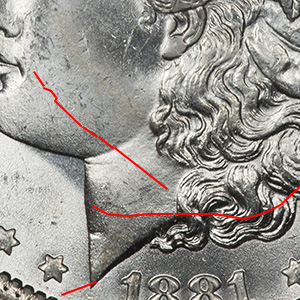
VAM 2B - O/O Low, Pitted NE-D
The associated VAM 2 and 2A require a second identifier to know what you have, but the VAM 2B only requires one. This VAM is characterized by a clash of the hair from Liberty's hair region onto the reverse. This is the only VAM with this exact clash, but there is another similar one.
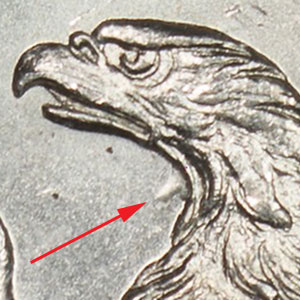
VAM 5 - O/O, Right Doubled 1
This is a Hit List 40 VAM and always a favorite. One reason we like it is that there are three ways to do a "One and Done" on this coin. But for this discussion let's stick to the one that best fits the description, the mint mark.
Over the years this has been described as O/S, O/O, Gouge in O, and now to the O/O, Right Doubled 1. It is the only VAM with this type deformation of the mint mark and you instantly know it when you see it.
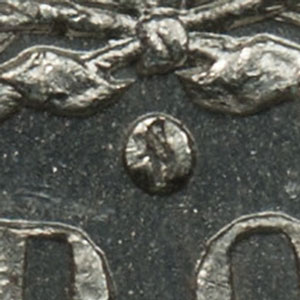
VAM 7 - O Set High
There is only one VAM in the 1881-O series with the mint mark set high enough to intersect the bottom of the ribbon. However, since we only have one the rarity of this VAM might be rather high.
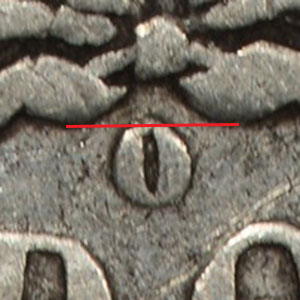
VAM 8 - O Tilted Right
When the mint mark is tilted in the 1881-O series it is most often tilted left, so this one should be easily identified, but we do not find it easy. The reason is that the right tilt is not pronounced and there are other VAMs where the tilt is considered to be within tolerance. To be a VAM 8 the coin must be devoid of other features, so to us it is a fall back placement.
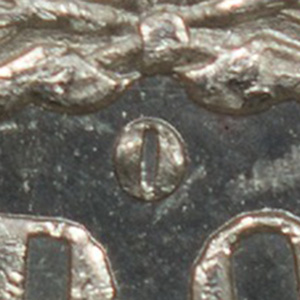
VAM 9 - Doubled 18, Dot in O
The VAM 9 has an unusual bit of debris in the middle of the mint mark that appears as a small dot. The coin has none of the other characteristics of a VAM 5, so there is no overlap with it. There are many 1881-O VAMs that involve date doubling, but none other with this mint mark.
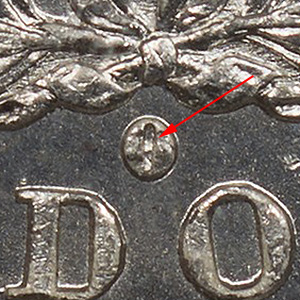
VAM 12 - O/O Lower Right
VAM 12 isn't supposed to be that rare, but so far we have located only one. It is distinguished by a doubled mint mark on the inside right that curves around the bottom. The obverse of the coin is a normal die but does have a small spike in the first 8. But this is not needed for identification.
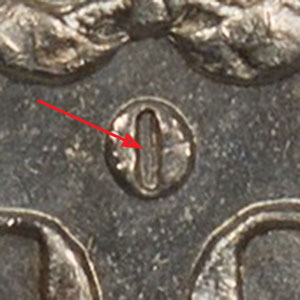
VAM 15 - Doubled 1
This is an older VAM discovered back in 1978 and easy to identify so long as you verify that there are no other features. There are many VAMs with date issues, so pinning this one down to just the doubling of the right 1 is needed.
The doubling of the 1 is more recognizable on the top flag as the doubling on the vertical shaft is only slight.
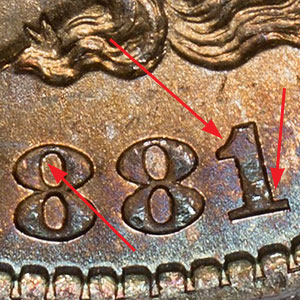
VAM 17 - Dash Under 8
VAM 17 was one of the early ones and is unique to the series because of the short dash under the second 8. Most believe that this dash was a registration mark for alignment of the date. If so then it should have been removed before the working die was made and it was just missed.
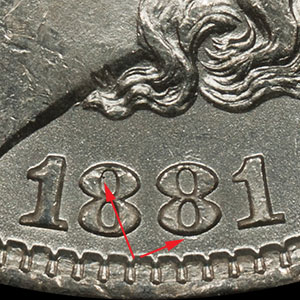
VAM 20 - Doubled 18
VAM 20 is one we often have problems with because it only has a date marker and the coin must be free of other features to qualify. The issue is that there is a tendency to read other features into a coin and holding a coin to just a date feature can be challenging.
On VAM 20 only the 18 in the date are doubled. The first one is doubled at the top of the vertical shaft. The first 8 is doubled at the inside of the bottom loop. This is a coin die with the chip in the upper loop of the first 8.

VAM 24 - Doubled Second 1
The distinctive doubling of the second 1 in the date makes VAM 24 unique. There are no other date digits doubled on this VAM.
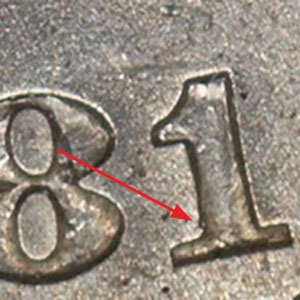
VAM 26A - Doubled 18, Clashed Obverse us
The 26A VAM has the same identification markers as VAM 26 but with the addition of clash marking on both the obverse and reverse. The clashing provides an opportunity to identify this VAM with a single marker.
Over and under the eagle's head the remnants of clashed hair from Liberty's head can be seen in a circular pattern. This clash pattern does not appear on any other VAM.
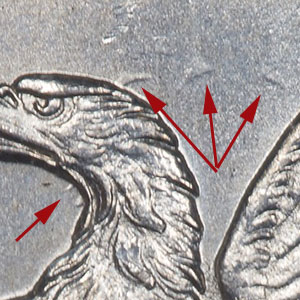
VAM 27 - Doubled Ear
VAM 27 is a Hot 50 VAM and has been recognized since the early 1990s as a significant variety. The doubling is so distinctive that it is hard to miss. The coin seems to be readily available below mint state but expensive and hard to find in mint state.
A not of caution when buying the VAM 27 is that buying a coin certified as this VAM is preferable to just trying to find one. The flat area behind the ear where the hair ends is reflective and often shows up in photographs as doubling. It is best to pick these at a show where you can inspect the coin than to guess on-line.
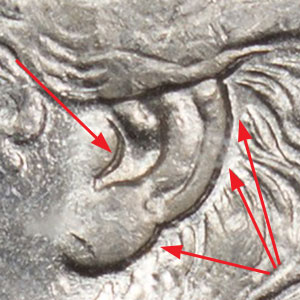
VAM 28 - Doubled Profile
We now recognize three different dies for the VAM 28, so we count this as one and done because we are not trying to separate the dies. Follow the link above to see those distinctions.
VAM 28 is distinguished primarily by the strong profile doubling and once you see it you will easily recognize it. The doubling is very obvious at the mouth, but also visible above and below.
Another note is that we most often find the VAM 28 in either PL or DMPL condition. This probably indicates that the coins were in a bag that stayed in the Mint vaults and were not released until the mid 1900s or later. We have found seven coins below the PL and DMPL condition, but these seem to be rare.
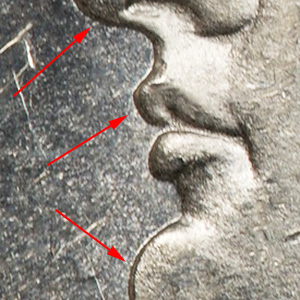
VAM 34 - Doubled 18
We have only found one of these and only in a circulated state. Like so many of the 1881-O series date doubling is a key and on this VAM it is the only distinguishing feature. The 1 is slightly doubled on the left side of vertical shaft. The first 8 is doubled on the surface of the right outside of the upper loop and the top right inside of the lower loop.
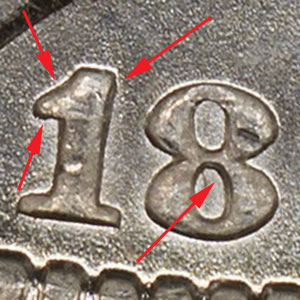
Getting Started
Collecting The 1881-O
The 1881-O VAMs




















